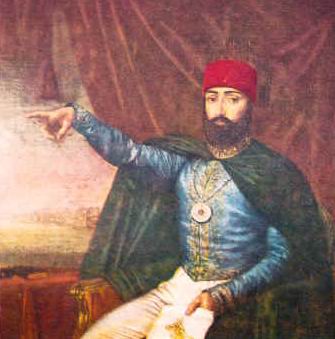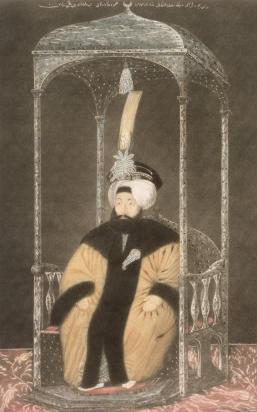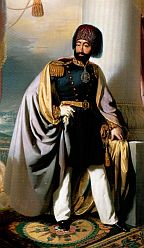<Back to Index>
- Explorer Paweł Edmund Strzelecki, 1797
- Painter Max Liebermann, 1847
- Sultan of the Ottoman Empire Mahmud II, 1785
PAGE SPONSOR

Mahmud II (Ottoman Turkish: محمود ثانى Mahmud-ı sānī) (20 July 1785 – 1 July 1839) was the 30th Sultan of the Ottoman Empire from 1808 until his death in 1839. He was born in the Topkapi Palace, Constantinople, the son of Sultan Abdul Hamid I. His reign is notable mostly for the extensive legal and military reforms he instituted, which culminated into the Tanzimat (Reorganization) that was carried out by his sons Abdülmecid I and Abdülaziz I. His mother was Valide Sultan Naksh-i-Dil Haseki (there have been speculations that she was a cousin of Napoleon's wife Josephine, but this is now widely regarded as false).
In 1808, Mahmud II's predecessor (and half-brother) Mustafa IV (1807 – 08) ordered his execution along with his cousin, the deposed Sultan Selim III (1789 – 1807),
in order to defuse a rebellion. Selim III was killed, but Mahmud was
safely kept hidden by his mother and was placed on the throne after the
rebels deposed Mustafa IV. The leader of this rebellion, Mustafa Bayrakdar, then became Mahmud II's vizier. There
are many stories surrounding the circumstances of his attempted murder.
A version by the 19th century Ottoman historian Cevdet Pasha gives the
following account: one of his slaves, a Georgian girl
named Cevri, gathered ashes when she heard the commotion in the palace
surrounding the murder of Selim III. When the assassins approached the
Harem chambers where Mahmud was staying, she was able to keep them away
for a while by throwing ashes into their faces, temporary blinding
them. This allowed Mahmud to escape through a window and climb onto the
roof of the Harem. He apparently ran to the roof of the Third Court
where other pages saw him and helped him come down with pieces of
clothes that were quickly tied together as a ladder. By this time one
of the leaders of the rebellion, Alemdar Mustafa Pasha arrived with his armed men and upon seeing the dead body of Selim III proclaimed Mahmud as padishah. The slave girl Cevri Kalfa was awarded for her bravery and loyalty and appointed haznedar usta,
the chief treasurer of the imperial Harem, which was the second most
important position in the hierarchy. A plain stone staircase at the Altınyol (Golden Way) of the Harem is called Staircase of Cevri (Jevri) Kalfa, since the
events apparently happened around there and are associated with her. The vizier took the initiative in resuming reforms that had been terminated by the conservative coup of
1807 that had brought Mustafa IV to power. However, soon the vizier was
killed by Ibrahim's army, and Mahmud II temporarily abandoned the
reforms. Mahmud II's later reformation efforts were more successful. During the early years of Mahmud II's reign, his Egyptian viceroy Mehmet Ali Paşa successfully reconquered the holy cities of Medina (1812) and Mecca (1813) from the Nejdi rebels. His reign also marked the first breakaway from the Ottoman Empire, with Greece gaining its independence following
a rebellion that started in 1821. In 1827 the combined British, French
and Russian navies defeated the Ottoman Navy at the Battle of Navarino; in the aftermath, the Ottoman Empire was forced to recognize Greece with the Treaty of Constantinople in July 1832. This event, together with the occupation of the Ottoman province of Algeria by France in
1830, marked the beginning of the gradual break-up of the Ottoman
Empire. Non-Turkish ethnic groups living in the empire's territories,
especially in Europe, started their own independence movements. Among Mahmud II's most notable acts during his reign was the abolition of the Janissary corps
in 1826, which permitting the establishment of a Turkish
dominated Ottoman Army; Mahmud was also responsible for the subjugation
of the Iraqi Mamluks in 1831. He ordered the execution of the renown Ali Pasha of Tepelena, an 80 years old man, for condemning The Auspicious Incident. He sent his Grand Vizier to execute the Bosnian Muslim hero Husein Gradaščević. The preparation of the Tanzimat reforms took place in 1839. The Tanzimat marked the beginning of modernization in Turkey,
and had immediate effects on social and legal aspects of life in the
Empire, such as European style clothing, architecture, legislation,
institutional organization and land reform. He is also responsible for the
destruction of Elite Muslim Military Orders. He
was concerned also with aspects of tradition. He made great efforts to
revive the sport of archery. He also ordered his archery student,
Mustafa Kani, to write a book about the history, construction, and use
of Turkish bows, from which comes most of what is now known of Turkish bowyery.
Mahmud II died of tuberculosis - some say murdered - at the Esma Sultana Palace, Çamlıca, in 1839. His funeral was attended by crowds of people who came to bid the Sultan farewell. His son Abdülmecid succeeded him. He married firstly an unknown wife and had one sin. He married secondly HH Valide Sultan Bezmiâlem, originally named Suzi (1807 – 1852), a Russian Jew, mother of Abdülmecid I. He married thirdly an unknown wife who bore HIH Prince Şehzade Kemaluddin Efendi. He married fourthly HH Valide Sultan Pertevniyal, originally named Bezime (1812 – 1883), and had Abdülaziz I. The name of his fourth wife is also spelled as "Partav-Nihal". By 1868, Pertevniyal was settled in the Dolmabahçe Palace. That year Abdülaziz led the visiting Empress Eugénie of France to see his mother. Pertevniyal perceived the presence of a foreign woman within her quarters of the seraglio as an insult. She reportedly slapped Eugenie across the face, almost resulting in an international incident. The Pertevniyal Valide Sultan Mosque was built under the patronage of his mother. The construction work began in November 1869 and the mosque was finished in 1871. Among his reforms are the edicts (or firmans), by which he closed the Court of Confiscations, and took away much of the power of the Pashas. Previous
to the first of the Firmans the property of all persons banished or
condemned to death was forfeited to the crown; and a sordid motive for
acts of cruelty was thus kept in perpetual operation, besides the
encouragement of a host of vile Delators. The second firman removed the ancient rights of Turkish governors to doom men to instant death by their will; the Paşas, the Ağas,
and other officers, were enjoined that "they should not presume to
inflict, themselves, the punishment of death on any man, whether Raya
or Turk, unless authorized by a legal sentence pronounced by the Kadi,
and regularly signed by the judge." Mahmud also created an appeal
system by a criminal to one of the Kazasker (chief military judge) of
Asia or Europe, and finally to the Sultan himself, if the criminal
chose to persist in his appeal. About
the same time that Mahmud II ordained these changes, he personally set
an example of reform by regularly attending the Divan, or state
council, instead of secluding himself from the labors of state. The
practice of the Sultan avoiding the Divan had been introduced as long
ago as the reign of Suleiman I,
and was considered as one of the causes of the decline of the Empire by
a Turkish historian nearly two centuries before Mahmud II's time. Mahmud II also addressed some of the worst abuses connected with the Vakifs,
by placing their revenues under state administration. However, he did
not venture to apply this vast mass of property to the general purposes
of the government. In
his time the financial situation of the Empire was troubling, and
certain social classes had long been under oppression under difficult
taxes. In dealing with the complicated questions that therefore arose,
Mahmud II is considered to have demonstrated the best spirit of the best of the Köprülüs.
A Firman of February 22, 1834 abolished the vexatious charges which
public functionaries, when traversing the provinces, had long been
accustomed to take from the inhabitants. By the same edict all
collection of money, except for the two regular half-yearly periods,
was denounced as abuses. "No one is ignorant," said Sultan Mahmud II in
this document, "that I am bound to afford support to all my subjects
against vexatious proceedings; to endeavour unceasingly to lighten,
instead of increasing their burdens, and to ensure peace and
tranquility. Therefore, those acts of oppression are at once contrary
to the will of God, and to my imperial orders." The haraç,
or capitation-tax, though moderate and exempting those who paid it from
military service, had long been made an engine of gross tyranny through
the insolence and misconduct of the government collectors. The Firman
of 1834 abolished the old mode of levying it, and ordained that it
should be raised by a commission composed of the Kadı, the Muslim governors, and the Ayans, or municipal chiefs of Rayas in
each district. Many other financial improvements were effected. By
another important series of measures, the administrative government was
simplified and strengthened, and a large number of sinecure offices
were abolished. Sultan Mahmud II provided a valuable personal example
of good sense, and economy, organising the imperial household,
suppressing all titles without duties, and all salaried officials
without functions. Mahmud
II dealt effectively with the military fiefs, the "Tımar"s and the
"Ziamet"s. These had been instituted to furnish the old effective
military force, but had long ceased to serve this purpose. By attaching
them to the public domains, Mahmud II materially strengthened the
resources of the state, and put an end to a host of corruptions. One of
the most resolute acts of his ruling was the suppression of the Dere Beys,
the hereditary local chiefs (with power to nominate their successors in
default of male heirs), which, in one of the worst abuses of the
Ottoman feudal system, had made themselves petty princes in almost
every province of the empire. The
reduction of these insubordinate feudatories was not effected at once,
or without severe struggles and frequent insurrections. Mahmud II
steadily persevered in this great measure and ultimately the island of Cyprus became the only part of empire in which power not emanating from the Sultan was allowed to be retained by Dere Beys. His most notable achievement was the abolition of the Janissary corps in 1826 and the establishment of a modern Ottoman Army, named the Nizam-ı Cedid (meaning New Order in Ottoman Turkish). Following the loss of the Ottoman Vilayet of Greece after the Battle of Navarino against
the combined British, French and Russian fleets in 1827, Mahmud II gave top
priority to rebuilding a strong Ottoman naval force. The first steam
ships of the Ottoman Navy were acquired in 1828. In 1829 the 62x17x7 m ship of the line Mahmudiye,
the world's largest warship for many years, which was armed with 128
cannons on 3 decks, was built by the Imperial Naval Arsenal on the Golden Horn in Constantinople.

